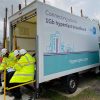Openreach to Start Closure of 105 National UK Exchanges in April 2025

Network operator Openreach (BT) has confirmed that they will kick off their project to close around 4,600 of their legacy exchanges from 1st April 2025, starting with the introduction of a “stop sell” on new service provisions for an initial batch of 105 sites (due to complete by around 2030/31). This will impact various broadband, PIA and Ethernet services from ISPs.
Just to recap. Openreach currently runs c. 5,600 UK exchanges, but only c. 1,000 of these – the Openreach Handover Points (OHPs) – are used to provide nationwide coverage of modern “fibre broadband” based services (FTTC, FTTP etc.). However, the rollout of full fibre, combined with the retirement of copper lines and legacy services (ADSL, WLR etc.), will make it economically unviable to support both the old and new exchanges.
The operator thus formed a long-term plan to close the vast majority of their older exchanges – known as the Exchange Exit Programme. The aim is to conduct an initial closure of 105 priority exchanges by 2030, with the rest following gradually in the years thereafter. Openreach is already in the process of piloting the closure of an initial 3 exchanges (Deddington, Ballyclare and Kenton Road), with all of those set to have been fully decommissioned by the end of May 2026.
Advertisement
The key goal of this “hugely complex” process is to ensure that all customers are migrated safely and with minimal disruption, which means that the process cannot be rushed, and each individual exchange will thus move toward decommissioning through a series of phases over a period of around 4-7 years (depending upon the complexity of each exchange) – starting with a Stop Sell. After that comes various planning, build and customer migration phases (the latter lasts for c.2 years or more).
In terms of the 4-year approach, the first 3 years would focus on encouraging voluntary migration and using “stop sells” on old products (i.e. you can’t buy them any more), while the final year will involve “supported migrations” or the risk of your service being ceased if the retail internet/phone provider fails to achieve this (in theory, most consumers won’t notice the change). ISPs will also be expected to remove their kit from exchanges in the final year.

Openreach has previously warned that a tiny portion of premises may still be negatively impacted by exchange closures, such as in locations where Fibre-to-the-Premises (FTTP) broadband coverage has not quite achieved universal reach (the vast majority of closures take place after 2030, thus most of the UK will have been reached by FTTP lines). In those cases, the operator may be unable to provide FTTP to every single property (i.e. issues of prohibitively high costs and permissions/consents to cross private land etc.) and “in these scenarios, customers may need to seek an alternative provider or technology solution.”
Advertisement
The operator is also having to grapple with the thorny issue of Ethernet, Dark Fibre (DFX) and PIA (access to existing cable ducts and poles) solutions, which are still supplied by quite a few of the old exchanges. Alternative networks have previously warned that the costs involved with adapting to this could be significant (here) – risking their investments becoming unviable. However, it is known that both Openreach and network operators have been working to find as many viable solutions to these challenges as possible, with some success. But a few operators still expect difficulties.
Otherwise, Openreach have chosen the first 105 exchanges based on a variety of different factors, such as their FTTP coverage, location (avoiding resources contention), volume of Ethernet and optical customers served, and complexity of the exchange itself. In addition, issues of expiring leases and other cost impacts have also played a role.
The operator has also previously said that they would prioritise exchanges where the potential benefits of exit are highest (e.g. those with very high running costs). But just to be clear, the operator will NOT be withdrawing exchanges in areas where doing so would leave lots of existing customers disconnected (i.e. no fibre or FTTC alternatives).
The First 108 Exchange Exits (inc. Pilots)
Advertisement
| SAU MDF ID | 1141 code | Exchange Name |
| MYADD | ABP | Addingham |
| THAD | ACM | Aldershot |
| EMALLES | ALP | Allestree Park |
| LVAUG | AUT | Aughton Green |
| NIBC | BXR | Ballyclare |
| CLWOO | L/BND | Baynard (Wood St.) |
| WEWBAY | L/BAY | Bayswater |
| CMBEAC | BM/BCN | Beacon |
| LSBET | L/BW | Betchworth |
| THBW | BLW | Blackwater |
| LSBKM | L/BK | Bookham |
| SDBRCKL | JKY | Bracklesham Bay |
| MRBRA | MR/BRA | Bramhall |
| EABRI | BON | Brightlingsea |
| SDWTHDN | BR/C | Brighton Withdean |
| NIC | CTT | Carrickfergus |
| LSCTHM | L/CV | Caterham |
| EACHF | CFO | Chafford |
| NDMED | CH | Chatham |
| WWCHEL | TCG | Chelston |
| LVCHI | LV/CHI | Childwall |
| MRCHI | ZNL | Chinley |
| LWCHI | L/CHI | Chiswick |
| LWCHO | L/CH | Chorleywood |
| EMCOGEN | ZNH | Cogenhoe |
| LNCED | L/MOU | Crouch End |
| SMDD | DBA | Deddington |
| SLDCN | DC/N | Doncaster North |
| CMDD | DD | Dudley; West Midlands |
| ESCRA | EH/CRA | Edinburgh Craiglockhart |
| LNEDM | L/EDM | Edmonton |
| LSESH | L/ER | Esher |
| LSFARB | L/FB | Farnborough; Kent |
| LNFIN | L/FIN | Finchley |
| LVGAT | LV/GAT | Gateacre |
| WSPRO | GW/PRO | Glasgow Provanmill |
| NIGGY | GGY | Glengormley |
| EAGRA | GRT | Grays Thurrock |
| NDGUE | HS/GL | Guestling |
| LWHARR | L/HAR | Harrow |
| SLHX | HFY | Haxey |
| WMHX | RJ/HC | Headless Cross |
| THHN | FGX | Headley Down |
| EAHTF | HJ | Hertford |
| CLHOL | L/HOL | Holborn |
| SMHGN | FGR | Holmer Green |
| LWHOU | L/HOU | Hounslow |
| WEWBLO | L/MUS | Howland Street |
| THIP | IP | Iver |
| WRKGDN | L/WES | Kensington Garden |
| LWKROA | L/WOR | Kenton Road |
| LSKIN | L/SWS | KINGSTON SSC (Taverner House) |
| CMKNO | KEG | Knowle |
| SMLA | LFZ | Langford |
| LNLVY | L/LV | Lea Valley |
| SMLEA | LGV | Leagrave |
| LVCEN | LV | Liverpool Central |
| SSLON | LMG | Long Ashton |
| ESLUN | LKI | Lundin Links |
| WWMSMT | MSU | Mawnan Smith |
| WEWMAY | L/MAY | Mayfair |
| CMMLD | BM/MID | Midland |
| LSMOG | L/MG | Mogador |
| WNM | MLG | Mold |
| CLMON | L/AVE | Monument |
| WSMOT | MOO | Motherwell |
| LNNAZ | L/NZ | Nazeing |
| CLNEW | L/NEW | New Cross |
| NDNEI | NCS | Newick |
| LSNCHM | L/FAI | North Cheam |
| WEWNPN | L/NPN | North Paddington |
| NDOTF | OTF | Otford |
| WEWPAD | L/PAD | Paddington |
| WRPIM | L/VIC | Pimlico |
| LWPIN | L/PIN | Pinner |
| SWPN | PN/BU | Pontypridd |
| WEWPRI | L/PRI | Primrose Hill |
| LSPUR | L/UPL | Purley |
| EARDH | RMN | Ramsden Heath |
| LSRIC | L/RIC | Richmond Kew; Surrey |
| MYRPP | RDV | Ripponden |
| SSSHM | SHU | Shepton Mallet |
| CLSHO | L/SHO | Shoreditch |
| NDSHO | SHN | Shorne |
| LWSKY | L/SKY | Skyport |
| EMSOSHM | SLS | Somersham |
| WWSOME | SLU | Somerton |
| WRSKEN | L/KEN | South Kensington |
| CLSOU | L/HOP | Southwark |
| LWSTAI | L/SI/B | Staines |
| LNSTF | L/MAR | Stratford |
| SSSOF | SFQ | Stratton On The Fosse |
| LSSTR | L/STR | Streatham |
| LSSUN | L/SY | Sunbury |
| NESU | SU | Sunderland |
| LSTHDT | L/EMB | Thames Ditton |
| LWUXB | L/UX | Uxbridge |
| LSWAN | L/VAN | Wandsworth |
| CLWAP | L/ROY | Wapping |
| LWWEM | L/WEM | Wembley |
| LSWEY | L/WB | Weybridge |
| WWWBAY | VIB | Widemouth |
| CMWDGT | BM/WOO | Woodgate |
| LSWOO | L/WOO | Woolwich |
| WMWR | WR/D | Worcester |
| SDWSWND | WG | Worthing Swandean |
| LWWRA | L/WU | Wraysbury |
| EAWRI | WPS | Writtle |
Mark is a professional technology writer, IT consultant and computer engineer from Dorset (England), he also founded ISPreview in 1999 and enjoys analysing the latest telecoms and broadband developments. Find me on X (Twitter), Mastodon, Facebook, BlueSky, Threads.net and Linkedin.
« ISPs BT, EE, Plusnet and Vodafone Tweak UK Broadband Pricing Policies























































Where will all the savings go? That’s right, shareholder pockets and CEO salary bonus. It won’t go on investment migrating to XGS-PON or newer, and offering symmetric services that are not ridiculously overpriced, or reaching out to alleged rural areas deemed too expensive or difficult!
The savings will largely go toward helping pay down the cost of deploying FTTP across the nation and to helping make the underlying economic case viable. Particularly given how many broadband line losses they’re suffering in a competitive market.
No empathy for BT here. They spent years sweating copper that was decaying, telling us all FTTC was fast enough and all we needed, whilst other countries got on with FTTP deployment.
If they hadn’t been so slow, the Altnets would not have deployed coverage to millions by now and no leaking of customers that is increasing day by day.
With the exception of Thatcher’s rules during the 80’s, this company has had long enough, but always chose the wrong product strategy because it was too tied up caring about leased lines for business as its only priority than investment in residential.
Openreach have more rural coverage than everyone else combined, and always has done. They are doing far more for the cause than any altnet.
You evidently missed the article about Openreach and Adtran (you didn’t seem to comment on it, anyway) – that is kit that is XGS capable.
And because it bears repeating – Openreach isn’t really losing many customers to altnets in fibred areas. (altnets that rely heavily on the use of Openreach infrastructure, of course)
At Ivor, BT have done more, so you say because they have been screwing the country for years with overpriced phone services and then broadband, so they should have the money for the infrastructure. Then, when you have government, local and national shoving money to BT that is even more of our money as if we, the public did not lose enough money as it was when they flogged it.
BT/openreach is a dinosaur and have been for years, need to be separated, not the false separation we have now.
BTIvor and friends will be happy when their shares increase.
I, for one, am glad that we have competition, it may not be making a huge dent in BT profits, but it has to be doing something.
@ Ad47uk
What evidence do you have to support the claim that BT is overcharging?
Calm down. Exchange closures are expensive and complex. Running a copper network alongside fibre is expensive. The buildings are leased. So no free lunch.
Well BT Ivor, and good to hear from you, five people in my inner circle are switching to Netomnia with one to City fibre. Admittedly all VM customers bar one BT fttp customer.
You say xgs-pon, but on another article, that is only a TRIAL in 2026, and as everything BT, would be 2027 before any form of non trial roll out. Meanwhile Netomnia would be on 50PON by end of 2025! They are also growing in size from having nothing.
And the so called 1gbps trial is on legacy GPON and priced extortionately as even the wholesale figure is ridiculous.
People don’t want to wait for BT to offer crippled products after years of waiting, that’s why the ALTNETS are a breath of fresh air …..
@Fara82Light, for years even before broadband we paid high prices just for a phone line, then they decided to have local calls included in it, only because I presume Mercury came on the scene.
BT have always been high-priced, even now they are still higher than a lot. They think they are the best and people will pay the higher prices, sadly they do.
The buildings are leased , so any exit is a cost saving not a money making opportunity
British Telecom as it was back in the day didn’t have a lot of choice for fibre. They were set to be world leaders until the government said no https://www.techradar.com/news/world-of-tech/how-the-uk-lost-the-broadband-race-in-1990-1224784
@ Ad47uk:
So you do not have any evidence, only your opinion based on your understanding of the matter.
Upgrading to xgs pon will be no simple feat. All those adtran leafs will need to be replaced , and then there is all the Nokia and subtended headends that will need replacing. That doesn’t touch all those on Huawei headends or dare I say it ECI which will doubt require a full migration to Nokia or Adtran
The Huawei and ECI stuff doesn’t need to go anywhere, two different chassis from two different vendors can happily provide GPON and XGSPON. No migration needed. Could provide XGSPON from the Huawei chassis but may decide not to. Just a line card though.
Believe the Nokia kit just needs line cards. Ditto the subtended ones, including Huawei.
The Adtran kit if it’s Total Access 5000 series just needs line cards. Only kit that can’t provide XGSPON is the SDX 6020-48. They’ve been installing the SDX 6330-48 for a little while now and those are all good.
All those card swaps, that’s an awful lot of night work!!?
And BTs own fault for continuing to deploy legacy GPON for past few years when most others were doing xgs-pon even VM under guise of Nexfibre.
Typical BT, deploy the wrong strategic choice then go cap in hand for another wave of tax payer money under grants to then spend years upgrading to another technology that has been superseded and not used anymore by competition.
Steve, well said! more people need to know how the UK was hamstrung by a political decision regarding FTTP>
Lots of buildings with empty frame rooms – I see a spate of new gymnasiums setting up. (That is not an investment hint!).
I wager many exchange buildings if not listed will be demolished and the space redeveloped for housing. They are usually in prime central areas, and also usually have space for some parking.
Id reckon the pre GPO buildings will be converted to flats/offices as they were mostly solid brick built to last. Most built after the 50s are only fit to be flattened
@real Witcher:
I don’t think they built many telephone exchanges before 1660.
Many exchange buildings were built in the 30s and 40s in major towns . London for example has many nice buildings with art deco features that could be turned into luxury flats. One I was in earlier has a lovely spiral staircase and high vertical glass windows .
The telephone boom of the 60s and 70s resulted in many new buildings designed and built on the cheap . The result is many are literally falling apart
@Witcher:
Kingston is a good example of both eras: the 1939 “Kingston” Exchange and the 1981 “Edward” SSC sat beside it. Prime land for redevelopment.
@plunet
Many are riddled with Asbestos, its going to be a tough sell
Interested to see my exchange (Primrose Hill) on the list.
Which is really in St. John’s Wood (Townsend street, easy to spot on Google streetview).
A nice brick building for a conversion to flats in a very nice area but probably will need asbestos remediation (flat owners would probably need to live with the mobile phone masts, but several other buildings also have these to boost coverage into Regent’s park)
Last I looked no OR FTTP available to my house (nearby to exchange), the only FTTP option at the moment is G.network (Virgin nearby but not in my street, not that I would choose that). Unless vorboss also starts offering residential (they came through the openreach ducting a few weeks ago)
The fun game in my area is to spot how long telephone service has been offered, by looking at the variety of names on the street box covers: PO Telegraphs, PO Telephone, various generations of BT logo (sandpiper, circle T), with the occasional cable company box, the odd Mercury box (if I recall correctly). And now Vorboss.
We at Constant Group are proud to be designing and manufacturing the solution for Openreach
What are you doing?
They make cabinets so potentially the cabinets that’ll house kit and cross connects to allow exchange closure.
https://www.constantgroup.co.uk/sectors/telecoms/
Brightlingsea is one typical example where Openreach has barely any fibre coverage at all. Will this town be completely abandoned by Openreach once the exchange is gone?
The can get the town covered in no time. The FTTP rolllout is extremely fast. So I’m sure it WILL be fully covered or the exchange won’t be closed.
Unlikely. Look out for OR installing sometime.
From mastdata:
Openreach works
31 Mar ’25 23:00 to 02 Apr ’25 00:00
Work description
BRIGHTLINGSEA 1168248 – POLING WORKS – Excavate for new BT Openreach Pole (s) or to Replace Existing BT Openreach Pole (s) in to facilitate overhead spine cabling works.
Promoter
Openreach
https://mastdatabase.co.uk/maps/streetworks/ is a useful source of information
FTTC doesn’t need the local exchange though – the fibre already runs back to the OHP (head-end exchange).
The only people who might lose service are those on EO lines with ADSL, and the numbers of those are pretty tiny. OR could either build FTTP to those particular customers, or deploy a small cab, or at worst push them onto 4G/5G (broadband USO)
The initial proposals document was quite clear that they do not anticipate that there will be 100pc FTTP coverage in exchange areas before they are closed, only that they are able to provide a service from the remaining OHPs.
@ Icaraa:
I am not sure that is the case. Openreach is not making much effort to provide FTTP to purpose-built multi-occupancy buildings. That is not just high-rise but low-rise apartment buildings. That will impact the roll-out targets in the major cities. For example, Kingston in London is in phase 4 of the list of 103 exchanges to be closed by 2030, but the roll-out of Openreach’s FTTP has only achieved about 30pc and has not moved much in recent years. When last checked, there were still no plans to run fibre to whole areas of Kingston.
The Facts: The https://mastdatabase.co.uk/maps/streetworks/ is not useful at all, at the most it gives clues about how Openreach has no big plans to cover this place with a whole town fibre network.
Your defense for such an incompetent company is astonishing, BT is more than a decade behind of where it should be. As of February 2025, Openreach’s full-fibre broadband (FTTP) network only reaches 50% of UK premises. And while Openreach has conducted trials of XGS-PON technology, they currently do not widely use it commercially, instead primarily relying on the old GPON for their fiber network.
@GNewton:
BT has been dogged by government intervention. The Huawei kit swapout has caused significant expense and delay. Sweeping statements just ignore the complexity of the situation BT is in.
Full Fibre Ltd seem to cover most of your town.
Openreach details are here – https://www.openreach.com/fibre-broadband/where-when-building-ultrafast-full-fibre-broadband
The details I gave were to help you see there may be something going on. No fibre companies give detailed plans as they were told off by the ASA years ago.
I’m surprised to see Bayswater on that list – there’s not currently much of a sniff of OR FTTP anywhere between Paddington and Shepherd’s Bush…
My flat is in the footprint of that exchange and can get Virgin Media (so I’m fine) – but can only get ADSL from OR….
Is this achieved by moving copper lines to a nearby exchange?
@The Facts: No, fully copper lines [ADSL] will be terminated as the distance to another exchange will put the service out of reach, the numerous amount of exchanges was required to power the PSTN and eventually ADSL broadband services. the point of closing exchanges is to decommission ADSL completely as the technology is ancient and also because modern broadband doesn’t come from the local exchanges dotted all over the country, but only from a fifth of the estate. A customer who is still on ADSL tech but can receive VDSL will be moved to the VDSL service automatically: of course, if FTTP is available, that will be the route taken to migrate the customer. By the time the exchange is closed, all customers would be off ADSL and those which can’t get VDSL or FTTP at that point will just have to move to mobile or satellite broadband, or find an altnet that services them.
FTTP doesn’t come from these exchanges, it’ll be the handover point upstream of the ones listed.
Harrow and south Kensington are both headend/handover exchanges
@ Cognizant:
About 40 of the exchanges on the above list are OHPs.
@SEG – Although 5 London exchanges were closed in the past and the copper moved. Ok if the distances worked.
The Openreach Exchange Exit workbook only lists 959 exchanges that will remain operational, or “enduring exchanges”.
I’ve managed to find a map for that, any idea if there’s a list with names rather than rough locations?
@ Darren:
Yes, they are listed in the workbook.
I am not sure if links are allowed, but see here:
The Exhange Exit Programme page:
https://www.openreach.co.uk/cpportal/products/the-all-ip-programme/exchange-exit-programme
The workbooks are listed under the “Exchange Exit list” pull-down tab at the bottom of the page. Download issue 25 and then go to the “Enduring Exchange” sheet in the workbook.
@Lee:
Sorry, I addressed the above to the wrong person.
@Lee – where is the map?
Exchange decommissioning is probably done like this https://youtu.be/saRir95iIWk?si=87ev9uFDRYJTyZcd
Nothing to it really
How delightfully 80s!
How USAian!
In 1984 the exchange transfer (cut over) I was on we did a 10,000 line transfer in under 5 seconds. No cutting of cables. New kit would would connected (jumper) from the exchange side of the Main Distribution frame to the line side of the MDF. The transfer was all done on the exchange side of the MDF – 100 lines per wire jumper block on the new kit, 20 or 40 lines per wire jumper block on the old kit. Break plugs on the old kit, make plugs on the new kit. On the instruction to change over all the break plugs would be actioned – the wedge making the connection were all strung together so it was pull a string to disconnect and the make plugs (actually a wedge in the test point) all pulled on the new kit. Once that was done the old jumpers could be removed at leisure. Quick change over with minimal problems.
In the 2000’s in an analogue exchange a ‘cut & join’ IDC in blocks of 64 lines (128 connectors) is used – cuts the old off and connects the new in one action – done in groups of 192 lines – one man to 6 groups. With the conversion to VoIP the single line transfer is a code change in the exchange to direct the call to the VoIP switch.
The exchanges are owned (well leased mostly) and run by BT Group. Not sure why you think the Openreach part of the company owns the exchanges. Most of the equipment in them is BT equipment, not Openreach. Openreach primarily manages the external network.
Please correct this.
Most of BTs sites are owned by Land Securities, as the result of a stupid sale and lease back arrangement. Such arrangements are never a good deal.
Closing the Sunbury exchange what will happen to most of Sunbury that is on copper wire . I enquired about fibre and have been told that they don’t not have any plans to replace copper wire . So we are left with slowest of all internet .
See https://labs.thinkbroadband.com/local/index.php?tab=2&election=1#13/51.4080/-0.3882/geafttp/
Sunbury FTTC is is connected to Molesey exchange so won’t be affected. Those on ADSLx or exchange only lines will be migrated to either FTTC/P or can choose an alnet if available
Fara82Light – erm just this week, compare the cost of BT symmetric 1gbos wholesale which has to have the ISP’s overheads, profit added as well compared to say Netomnias £31.99 per month to actual customer, or community fibres even lower charge.
The BT price difference is outstanding; even much more expensive than VMs 1gbs symmetric on Nexfibre, a lot more.
You are not comparing like for like. The AltNets are being funded via debt to capture market share, but that will not last forever, and it may already be coming to an end as the shake-out has started. BT also has a much higher cost base than AltNets, that do not have the same sort of obligations or government intervention.
@Fara82Light It costs basically no more for Openreach to sell symmetrical. They have priced it high to deter take up, not because of a cost base. They were contracted to offer the product. Which obviously also means the pricing is in no way reflective of how Openreach could price it if so minded so no real comparison either way.
The original privatisation of BT protected the local network. This was sensible at the time. What is wrong is that no government since has changed this so we duplicated fibre networks and in my street triplicated. A total waste of capital, which pushes up rental prices for all. There should be compulsory infrastructure sharing.
That is exactly what we do not want. Gifting monopolies to the mercy of potentially militant unions has been demonstrated to be a bad idea since the days of post-war nationalisation.
@MG – 40 years too late.
What I’d like to know is will the exchange closure program improve fixed line number mobility (less tied to a location).